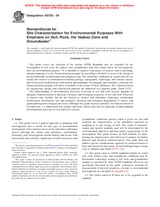Potrebujeme váš súhlas na využitie jednotlivých dát, aby sa vám okrem iného mohli ukazovať informácie týkajúce sa vašich záujmov. Súhlas udelíte kliknutím na tlačidlo „OK“.
ASTM D5730-04
Standard Guide for Site Characterization for Environmental Purposes With Emphasis on Soil, Rock, the Vadose Zone and Groundwater (Withdrawn 2013)
Automaticky preložený názov:
Štandardné Sprievodca pre Site charakterizácia na účely v oblasti životného prostredia s dôrazom na pôdu , Rock , Vados zóny a podzemné ( Withdrawn 2013 )
NORMA vydaná dňa 1.1.2004
Informácie o norme:
Označenie normy: ASTM D5730-04
Poznámka: NEPLATNÁ
Dátum vydania normy: 1.1.2004
Kód tovaru: NS-32313
Počet strán: 34
Približná hmotnosť: 102 g (0.22 libier)
Krajina: Americká technická norma
Kategória: Technické normy ASTM
Anotácia textu normy ASTM D5730-04 :
Keywords:
conceptual site model, environmental site characterization, exploration, feasibility studies, field investigations, geological investigations, geophysical investigations, ground water, hydrologic investigations, maps, preliminary investigations, reconnaissance surveys, sampling, site characterization, site investigations, soil surveys, subsurface investigations, ICS Number Code 13.060.10 (Water of natural resources), 13.080.01 (Soil quality in general)
Doplňujúce informácie
| Significance and Use | ||||||||||||||||||||||||||||||||||||||||||||||||||||||||||||||||||||||||||||||||||||||||||||||||||||||||||||
|
This guide provides a general approach to environmental site characterization. Environmental site characterization provides information for a wide variety of uses including: Determination of ambient background or baseline conditions, including, but not limited to, geochemistry, hydrogeology, microbiology, mineralogy, and water quality. Assessment of site suitability for a future use or a use which may be compromised by site characteristics, such as flooding, seismic activity, and landslides (mass wasting). Protection of site quality from the detrimental effects of human activities and natural processes, or minimization of adverse environmental impacts. Specific examples of uses of environmental site characterization for these purposes include: (1) delineation of groundwater or wellhead protection areas, (2) assessing the suitability of sites for disposal of industrial and residential liquid and solid wastes, (3) assessing soil suitability for land treatment of wastes, and (4) evaluating soil suitability for agricultural practices in order to minimize soil erosion and contamination from agricultural chemicals. Assessment of the type, distribution, and extent of surface and subsurface contamination to determine compliance; risk to human health and the environment; and responsibility for remediation. Such assessments include: (1) sites involved in real estate transactions, (2) controlled and uncontrolled hazardous waste sites, (3) controlled and uncontrolled municipal solid waste, wastewater, and other nonhazardous waste disposal sites. Assessment of surface and subsurface environmental processes that affect the fate, mobilization, and rate of transport of natural and anthropogenic chemicals in the subsurface. Assessment of the type, distribution, and extent of natural and anthropogenic radioactive elements in the subsurface. Assessment of the degree of risk that adverse subsurface site conditions not related to 4.1.4 and 4.1.5 pose to human health and safety or the natural ecosystem. Selection and design of remediation systems for cleanup of subsurface contamination and of other reclamation or rehabilitation practices on disturbed land. This guide is meant to be a flexible description of investigation requirements; methods defined by other ASTM Standards (Appendix X1) or non-ASTM techniques (Appendix X2) may be appropriate in some circumstances. The methods and amount of effort required for environmental site characterization will vary with site conditions and objectives of the investigation. This standard does not set mandatory guidelines and does not constitute a list of necessary steps or procedures for all investigations. In karst and fractured rock hydrogeologic settings, this guide should be used in conjunction with Guide D5717. |
||||||||||||||||||||||||||||||||||||||||||||||||||||||||||||||||||||||||||||||||||||||||||||||||||||||||||||
| 1. Scope | ||||||||||||||||||||||||||||||||||||||||||||||||||||||||||||||||||||||||||||||||||||||||||||||||||||||||||||
|
1.1 This guide covers a general approach to planning field investigations that is useful for any type of environmental investigation with a primary focus on the subsurface and major factors affecting the surface and subsurface environment. Generally, such investigations should identify and locate, both horizontally and vertically, significant soil and rock masses and groundwater conditions present within a given site area and establish the characteristics of the subsurface materials by sampling or in situ testing, or both. The extent of characterization and specific methods used will be determined by the environmental objectives and data quality requirements of the investigation. This guide focuses on field methods for determining site characteristics and collection of samples for further physical and chemical characterization. This guide does not address special considerations required for characterization of karst and fractured rock terrane. In such hydrogeologic settings refer to Quinlan and Guide D5717, (1). 1.2 This guide refers to ASTM standard methods by which soil, rock, vadose zone, and groundwater conditions may be determined. Laboratory testing of soil, rock, and groundwater samples is specified by other ASTM standards which are not specifically discussed in this guide. Laboratory methods for measurement of physical properties relevant to environmental investigations are included in Appendix X1. 1.3 The values stated in SI units are to be regarded as the standard. 1.4 This standard does not purport to address all of the safety concerns, if any, associated with its use. It is the responsibility of the user of this standard to establish appropriate safety and health practices and determine the applicability of regulatory limitations prior to use. 1.5 This guide offers an organized collection of information or a series of options and does not recommend a specific course of action. This document cannot replace education or experience and should be used in conjunction with professional judgment. Not all aspects of this guide may be applicable in all circumstances. This ASTM standard is not intended to represent or replace the standard of care by which the adequacy of a given professional service must be judged, nor should this document be applied without consideration of a project's many unique aspects. The word “Standard” in the title of this document means only that the document has been approved through the ASTM consensus process. |
||||||||||||||||||||||||||||||||||||||||||||||||||||||||||||||||||||||||||||||||||||||||||||||||||||||||||||
| 2. Referenced Documents | ||||||||||||||||||||||||||||||||||||||||||||||||||||||||||||||||||||||||||||||||||||||||||||||||||||||||||||
|




 Cookies
Cookies
